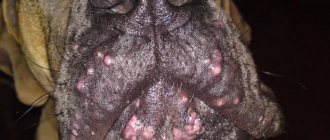Causes of itching
Most often, itching in the tail area in a dog occurs for the following reasons:
- Ectoparasites. For example - fleas. An allergy to flea saliva causes dermatitis and severe itching. Even if no parasites are visible on the dog, this does not mean that they do not exist;
- Allergy. Each organism is individual, so you can get an allergy to anything - food, new bedding, shampoo, food from the table... There are many options and each needs to be dealt with separately;
- Inflammation of the paraanal glands. Normally, they clear when the dog goes to the toilet “in a big way”, but if there are errors in nutrition, they can become inflamed.
- Stress.
Any of these reasons can cause irritation and itching in your dog's back. Very often our four-legged friends begin to itch after visiting the groomer. This could be due to the wrong shampoo/conditioner, aggressive drying with hot air, or stress.
Important! If you wash your dog at home, you should only do this with special shampoos for animals. Shampoo is a concentrate and must be diluted with water and whipped into foam. Wash your dog with this foam.
External parasites
The danger of external parasites is that in addition to the clinical signs of each disease they cause, an allergy may also appear. It occurs on the saliva of parasites, traces of their vital activity and on themselves. This seriously aggravates the course of the disease and, of course, requires veterinary intervention.
Fleas
– the most common cause of itching. One bite is enough for the animal’s body to give a violent reaction to flea saliva, and the dog begins to itch. Most owners do not even realize that their pet has fleas and are very surprised when they hear the diagnosis. It is very difficult to notice parasites. And if in the case of fleas we can still see them themselves (if we’re lucky) and traces of their vital activity, then with other parasites everything is more complicated.
For example, demodicosis
(a mite that lives in the hair follicles) can only be seen under a microscope and by itself it does not cause itching. But it significantly weakens the protective barrier of the skin and a secondary infection is added to the main disease (details about it below). And it already causes itching. The first symptom of demodicosis is baldness, the appearance of skin scales or small pimples (papules) with purulent contents on the head and bends of the limbs. The protective barrier of the skin gives way quickly, and the dog begins to itch almost as soon as bald patches appear.
Sarcoptic mange
- the same scabies. Another disease caused by an insidious external parasite - a mite of the genus Sarcoptes. This mite lives not on the skin, but in the skin, breaking passages there and laying eggs. As you might guess, the main and most obvious symptom of sarcoptic mange is severe itching. But an accurate diagnosis can be made only after examining the scraping under a microscope.
Associated symptoms of sarcoptic mange:
- First, bald patches appear on the bends of the elbows, knees, and on the ears - the dog frantically scratches these places and spreads parasites throughout the body;
- The affected areas are bald, the skin is thickened, sometimes swollen, has hyperpigmentation (darkening) and peeling;
- Grooming reflex. If you scratch an itchy place (especially the ears), the dog begins to twitch its back paw, as if it were itching itself;
- Complications of scabies are pyoderma (purulent skin lesions) and otitis media. Stray dogs unlucky enough to catch sarcoptic mange can become an itchy sore without treatment, and ear infections can develop into hearing loss;
- Pseudoscabies in the owner: humans can also suffer from sarcoptic mange. The dog may not yet have any clinical manifestations, but after contact with the dog, the person’s palms, forearms, neck, and chest itch (if the owner picks up the dog). The itching goes away after washing your hands or showering. This is an important symptom with which you can notice the disease at a very early stage. At the same time, the tick cannot reproduce on the human body and the symptoms disappear as soon as contact with the sick animal ceases.
Fortunately, sarcoptic mange is treatable. It is important to note that treatment should continue for 6 weeks (two life cycles of ticks), and possibly longer, depending on the “neglect” of the case.
Treatment of sarcoptic mange is complex.
- First of all, treat the dog with antiparasitic agents. Stronghold drops on the withers have shown excellent effectiveness in the fight against sarcoptic mange. The dose depends on the dog's weight. The drug is applied to the withers, to intact skin (if possible). It is important to carry out the treatment with drops in a course - twice, with an interval of a month. Further preventive treatments are also important - after all, Stronghold is used not only to treat sarcoptic mange, but also provides further protection against it (and more) for 30 days. Stronghold is active against: fleas, lice, lice, ear mites (otodectosis), causative agents of sarcoptic mange (scabies in dogs), heartworms (dirofilaria), round helminths living in the intestines. Contraindications for the use of Stronghold may be: individual intolerance to the drug and the age of the animal is less than 6 weeks. Treatment of pregnant and lactating dogs is also permitted. Simparica can also be used against sarcoptic mange - this is a tablet that, like Stronghold, not only treats, but also provides prevention. For sarcoptic mange, Simparica is given twice, with an interval of 30 days. A tablet is a convenient choice when there is “no living space” on the dog and there is simply nowhere to drop drops. Giving Simparika is not difficult - dogs eat it as a treat, because it has an attractive liver taste. In addition to scabies in dogs (sarcoptic mange), Simparica is used for the treatment and prevention of diseases such as demodicosis, flea infestation and otodectosis (ear scabies). Contraindications: individual intolerance, age less than 8 weeks, severe liver and kidney damage, infectious diseases.
- Regular washing with medicated shampoo throughout the healing process. By the way, when pre-treated with Stronghold, you can wash your dog 2 hours after applying the drops;
- Hygienic cleaning of the ears if sarcoptic mange has affected the ears;
- After the start of treatment, the itching intensifies significantly, so Apoquel is indicated for the first time. It is prescribed for a short period of time - from several days to two weeks. Prescribing such treatment will make the dog’s life much easier - after all, there will be no more debilitating itching. In addition, Apoquel is not a hormonal drug and is well tolerated by the dog’s body. Apoquel is prescribed by a veterinarian after diagnosis. You should not self-medicate.
If scabies (sarcoptic mange) is detected in one dog, it is very important to treat all animals in the apartment to avoid infection. You can also use Stronghold or Simparica for this purpose.
What if the fur comes out?
Bald patches are the consequences of itching. Above the tail and on the sides they can be caused by the same reasons as itching in general. Bald patches are caused by excessive licking of the itchy area by the dog itself. The most common cause of this itching is fleas. But why does the dog itch near its tail, what should I do?
Typically, a dog scratches its back close to its tail due to inflammation of the anal glands. The dog's itching at the base of the tail causes him discomfort, and the dog begins to actively gnaw the hair in this place and around the anus, and bald patches appear. The dog can also ride on the carpet, sitting low. A visit to the veterinarian and cleaning of the paraanal glands will solve this problem. Once the problem causing the itching is eliminated, new hair will grow in place of the bald patches.
Types of Pet Parasites
Dogs' skin can harbor parasitic insects, mites, and even helminths. The most common parasitic insect found on the skin of dogs is fleas. These are small, mobile parasites up to 4 mm in size that can be seen with the naked eye. Although fleas live on dogs and cats, their eggs, larvae and pupae are found in the environment, such as dust or carpet. Fleas often cause allergic dermatitis, for the treatment of which one treatment of the animal may not be enough and additional treatment prescribed by a veterinarian is required.
Another insect parasite of dogs is the lice beetle, the causative agent of trichodectosis. The size of this parasite is about 2 mm, they live on dogs and are transmitted by contact from sick dogs. Trichodectes do not live long in the environment; the entire development cycle lasts about a month.
Other common parasites in dogs are subcutaneous mites, which can only be seen with a microscope. For example, scabies in dogs, or sarcoptic mange, is caused by the parasitic mite Sarcoptes scabei (var. canis). Their size is only 0.2 - 0.5 mm.
Another parasitic cause of itching in dogs is cheyletiosis, popularly referred to as “fermenting dandruff.” This disease is caused by the Cheyletiella mite. The size of the tick is small (only 0.2 – 0.4 mm), which makes it impossible to see it with the naked eye. This mite causes itching and severe flaking of the skin and, moving along the surface of the skin, dragging these scales, creates the impression of moving dandruff.
Ear scabies, or otodectosis, is caused by the microscopic ear mite Otodectes cynotis. This parasite is most often detected by microscopy of earwax in dogs with itchy ears. Dogs can become infected not only from sick animals, but also from hidden carriers who do not show signs of the disease, but can transmit otodectosis, sarcoptic mange or cheyletiosis. It is important to remember that skin parasites can also be transmitted through grooming items, and even fleas can carry eggs and parasitic mites.
The subcutaneous mite Demodex canis causes a severe skin disease - demodicosis in dogs, which is not contagious. This mite is normally present in small numbers in the skin of healthy dogs, without causing harm, however, when immunity is reduced, demodexes begin to actively multiply and cause skin lesions and hair loss.
With mild demodicosis, young dogs can recover without treatment. However, severe demodicosis with extensive lesions leads to a further worsening of the decreased immune response, and often to secondary bacterial infections. In such cases, the animal may even die from exhaustion and blood poisoning. Dogs with a generalized form, as well as adult and elderly dogs with demodicosis, require treatment.
Photo. Demodex canis mite, the causative agent of canine demodicosis, under a microscope
Photo. A puppy suffering from generalized demodicosis, before and after treatment
Can worms cause itching and skin lesions in dogs? Most dog owners think of heartworms as worms that live in the digestive system. It is obvious that these intestinal parasites can lead to weakening of the body, exhaustion, and increased allergic reactions. A number of helminths, such as the cucumber tapeworm Dipylidium caninum, can cause itching at the base of the tail.
In addition, there are helminths that develop directly in the skin. For example, larvae of pelodera strongyloides, a free-living nematode that lives in rotting organic substrates (such as wet sawdust or soil), can cause inflammation and itching of the skin in dogs and humans. These helminths are not visible to the naked eye; their small size, less than one millimeter, allows L3 stage larvae and females to penetrate the skin. Peloderosis most often develops in the summer, but when dogs are kept in enclosures on rotting sawdust or in stables, it can occur out of season.
Another dermatosis caused by helminths is cutaneous dirofilariasis. Infection of dogs with heartworms (Dirofilaria repens, much less commonly Dirofilaria immitis) occurs through the bite of a mosquito or mosquito in the hot months.
Since it is not possible to completely avoid mosquito bites, regular use of drugs that have a detrimental effect on microfilariae (heartworm larvae that enter the dog’s bloodstream) can protect your pet from this disease.
Diagnosis of itching
The veterinarian will begin the diagnosis by collecting information about the dog's lifestyle. It is important for the doctor to know what the dog usually eats, errors in nutrition (food from the table, treats), as well as treatment of the dog for parasites. Typically the diagnostic plan is as follows:
- Anamnesis collection.
- Examination of the dog.
- Local inspection of scratching areas.
- Biochemical and clinical blood tests.
- Taking a scraping from the itchy area.
The diagnostic and treatment plan may change at the discretion of the doctor. Sometimes the solution to the problem lies on the surface, and the veterinarian can immediately answer why the dog’s back is itchy at the tail, and what to do about it. Your task is to strictly follow the instructions and listen to the recommendations of your doctor.
Allergy
Skin inflammation, or dermatitis caused by fleas and ticks, are not the only allergies that can cause a dog to scratch its tail. Environmental allergies—from pollen outside to household chemicals inside—can cause allergic reactions. Whether the source of your dog's allergies is mites, mold, or contact with other animals, the most severe reactions occur in the first years of a dog's life, from 3 months to 6 years.
A person's first instinct when they have a skin allergy is to scratch it, just like a dog. Interestingly, trying to treat one allergy can lead to the discovery of another. If your dog has sensitive skin, simple things like the shampoos or soaps you bathe him with can also trigger an allergic reaction.
Help your pet
It happens that diagnosis takes a long time, and debilitating itching and continuous self-scratching only aggravate the dog’s condition. Apoquel will help relieve symptoms during this time. It successfully relieves itching, and does not harm the body in any way. A huge advantage of Apoquel is that it can be used for a long time without any harm to the dog. This drug has no analogues. Apoquel is an absolute innovation in the world of veterinary dermatology. It relieves itching at the cellular level, beginning to act within 4 hours after giving the tablet. Apoquel is suitable both for allergies to flea saliva and will provide a comfortable life for an animal with atopic dermatitis.
Consult your veterinarian before use.
What to do if your dog is itching
In case of severe itching, to provide quick help, it is necessary to lubricate the affected area with anesthetic ointment. To alleviate the condition, your pet can be given an antihistamine, calculated strictly by weight.
But before you begin treatment, you need to understand why this happens. You should carefully examine the animal for the presence of blood-sucking parasites and analyze its diet (consumption of foods that can cause allergies). It is also necessary to remove all objects and chemicals that cause irritation.
If skin itching and damage to the surface of the body appears, as well as a deterioration in the general condition, it is necessary to show your pet to a veterinary dermatologist as soon as possible.
Self-administration of medications without a doctor's prescription can lead to increased skin itching and serious consequences. Long-term inflammatory reactions, infection of scratches and abrasions on the body cause the development of sepsis, severe complications and death of the pet.
To prevent such problems, you should treat your pet from blood-sucking parasites (if necessary), maintain hygiene, feed the animal properly (excluding allergens), avoid contact with irritating substances, and undergo medical examination by a veterinarian once a year to identify pathologies of internal organs.
Causes and treatment
Based on the examination results, the doctor will prescribe treatment. It always depends on the cause of the itching.
- Ectoparasites. The main treatment for flea infestation is parasite drops or tablets. For example, Stronghold or Simparica. In combination with them, you can wash your dog with a special anti-flea shampoo and put on a collar that provides protection against ectoparasites. Remember that fleas do not live on the dog, but only feed. The habitats of parasites are cracks in the floor, bedding, carpets, toys. Therefore, when treating your dog, do not forget to treat the dog’s apartment and household items with special products. The use of Apoquel during the treatment of flea dermatitis eliminates constant scratching of the skin, which promotes rapid healing of the affected areas.
- Allergy. Allergy treatment is always selected individually. When all allergens are excluded and the dog is treated for parasites, you can think about atopic dermatitis - one of the manifestations of allergies. Apoquel is the best option for maintaining a comfortable life in animals with atopic dermatitis.
- Paraanal glands. When the paraanal glands become inflamed, the animal experiences discomfort: the dog chews its back near and under the tail, and also “rides” on the carpet. Treatment in this case is complex - finding out the cause of itching, timely cleaning of the anal glands, anti-inflammatory and antibacterial therapy.
- Stress. Particularly impressionable animals are susceptible to itching after experiencing stress. The departure of a beloved owner, fireworks, a new family member - all this can provoke idiopathic dermatitis. To avoid exacerbations, contact a canine specialist for behavior correction or ask your doctor to prescribe sedatives for your dog in combination with Apoquel.
Remember that the best treatment is prevention. At the first signs of itching, immediately contact a veterinary clinic.
Hormonal imbalance
One of the most common causes of unscheduled shedding in a pet is hormonal imbalance. In this case, the hair grows abundantly, but the bald spots on the animal’s body are located symmetrically.
Baldness is caused by the following hormonal imbalances:
- In addition to bald spots, Cushing's syndrome (excess cortisol) is accompanied by other symptoms: weakened immunity, extreme thirst and excessive urination, excessive weight gain.
- Bald patches in the perineum indicate an excess of estrogen in females. Estrogen deficiency also leads to bald spots around the loop, but the coat becomes thinner and the skin becomes looser.
- With hypothyroidism, the dog's coat becomes dry and brittle, and characteristic bald patches appear on the neck, chest, back and other parts of the body. At the same time, the animal becomes lethargic and quickly gains weight.
- A disruption in the production of growth hormone during puberty can lead to sudden hair loss in males.
To correctly determine a hormonal disorder, the owner should contact a veterinarian. Only a doctor, based on tests, can make a diagnosis and prescribe treatment.
How to deal with tail scratching
As you can imagine, dogs that spend a lot of time scratching their tail, especially the base of the tail, can have a variety of problems. In fact, there is quite a rich set of reasons that can lead to compulsive tail scratching.
But, good news! Whether it's maintaining good hygiene with your dogs, determining if they are allergic to things or creatures in the house, treating small wounds before they develop secondary infections, or simply making sure they get better, - all these problems are curable.
Tell Us: Have you ever had a puppy or dog that seemed fixated on its tail area? Have you or your veterinarian been able to identify the underlying problem and successfully resolve it? Share your experience of scratching your dog's tail in the comments!
Author of the article : Melvin Peña.
Lacerated anal glands
Finally, another common reason why a dog scratches its tail until it bleeds is a diseased anal gland. And a dog's anal glands are important for a dog. Just like we shake hands when we meet people, canine anal glands secrete interesting fluids that dogs sniff when they meet each other. This is one of the reasons why dogs are so eager to sniff each other whenever possible.
One obvious sign that a dog has anal gland problems is when he runs away, sitting down and dragging his butt on the ground. Other symptoms include a foul-smelling dog's back than usual, trouble defecating (you call it constipation), and, in severe cases, blood or pus in the feces.
Injury
Any type of injury to the back or rear of the limbs - such as a broken tailbone - is something that a dog cannot communicate to its owner and may go undetected under normal circumstances. The intensity of a dog's pain may prompt him to act out or draw attention to it by excessively scratching his tail or other injured area. Only a veterinary x-ray will be able to correctly diagnose such a problem.
© shutterstock
Hot Spots
A hot spot is an area on a dog's body where repeated scratching or chewing results in an open wound. Warmth and humidity are optimal conditions for hot spots to form. If stray bacteria enter the site of infection before it has been properly treated, a secondary infection is the typical result. Identify the hot spot by blood, pus, and matted hair.
If your puppy or dog scratches its tail so often that it bleeds, then secondary infections are not the root cause of its problem, but just another symptom. Your veterinarian can help you determine whether the actual cause is related to hygiene, nutrition, or another factor.











